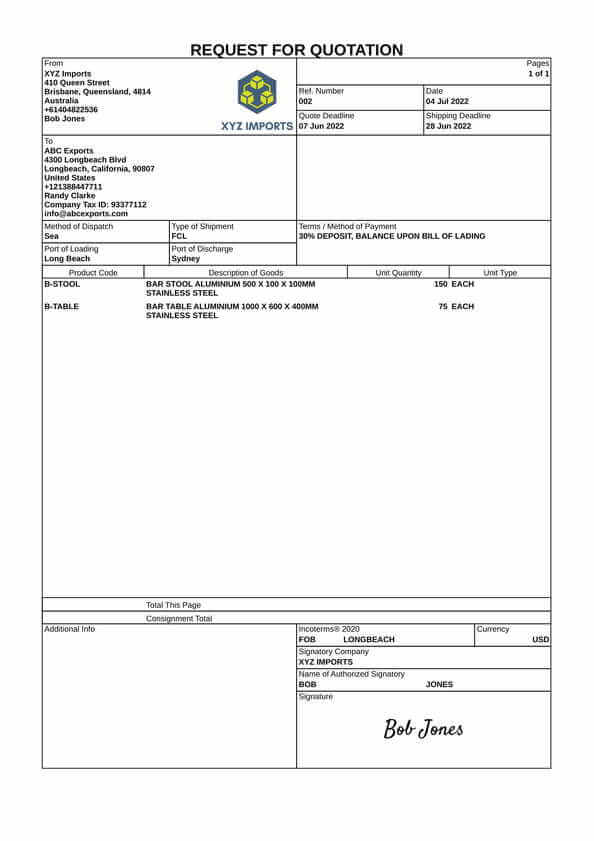IncoDocs raises $1.2M seed round led by Maersk GrowthRead the announcement

Request for Quotation Template
What is a Request for Quotation used for?
A request for quotation (RFQ) is used to give suppliers clear product information, including specifications, quantities, and delivery terms. The seller reviews the RFQ to confirm the requirements and then prepares a formal quotation with pricing and shipping details. If the buyer accepts, they issue a purchase order to authorise manufacturing and shipment. The seller then sends a proforma invoice, which reconfirms the goods on order and provides bank details for payment.
How to create a Request for Quotation
Open IncoDocs
Open IncoDocs in your browser and navigate to the 'Quotes' section.
Create a New Request for Quotation
Click on 'New Quote' and select the Request for Quotation from the dropdown menu.
Fill out & customize your doc
Fill out document info, customize document fields to your needs and add your company letterhead. If you use Xero or Quickbooks Online, you can also connect your account and autofill data from quotes in your accounting system.
Sign & Seal
Click on the signature box at the bottom of your document to create a reusable digital signature then hit “Save & Quit”. On the document preview screen, click on the ‘More’ dropdown button and select “Add company seal”.
Send & Win New Buyers
Share quotes from IncoDocs in 1-click. You'll know when recipients have viewed your quote so you know when to best follow up.
Your questions, answered.
What information is included on a Request for Quotation Document?
It’s important that the buyer includes as much specific product information as possible, to clearly communicate the details of the products that they want a quote for. The RFQ should contain information such as:
When would you use an RFQ?
A request for quotation is used when you need to buy products or services that are already standardised. The specifications are clear and will not change. This is common for large orders in industries like manufacturing, construction, and export trade. The RFQ process makes it easier to get pricing from different suppliers in the same format. You can compare offers quickly and choose the one that meets your needs. It works best when requirements are fixed and when price and payment terms are the main factors in your decision.
Who prepares and sends the RFQ?
The RFQ is prepared and sent by the buyer. In many companies this is handled by a dedicated purchasing team. The process starts with the buyer confirming exactly what is needed. This includes the technical details of the goods or services and any specific delivery requirements. Once the RFQ is complete it is sent to selected suppliers or exporters who are invited to submit their offers. Every supplier receives the same information so that each bid can be compared fairly. This makes it easier to review the responses and choose the supplier that best meets the evaluation criteria.
What is the difference between RFP and RFQ?
A request for quotation is used when the main goal is to get pricing for products or services that have clear and fixed specifications. Suppliers respond with their costs and delivery details based on those exact requirements. A request for proposal is broader and is used when the project is more complex. In this case the buyer also evaluates the supplier’s technical skills, work approach, and capacity to deliver, not just the price. A RFQ is best for fixed-spec goods, while an RFP works better for projects that need customised solutions or new approaches.
Which Comes First: RFI, RFQ, or RFP?
In most procurement processes, the order is:
How RFQs Are Managed in Procurement
A RFQ can be managed in different ways depending on the level of competition, confidentiality, and speed you want in the procurement process.
| Bid Type | How It Works | When to Use It |
|---|---|---|
| Open Bid | All offers are visible while bidding is active. | When you want strong price competition and visibility is not a concern. |
| Sealed Bid | Offers are kept confidential until the deadline. | When you need a formal process and want to prevent price matching. |
| Invited Bid | Only sent to selected, pre-qualified suppliers. | When you want to work with trusted suppliers or limit the number of bids. |
| Reverse Auction | Suppliers compete to lower their price in real time. | When reducing cost is the main goal and suppliers are ready to adjust quickly. |
How Do You Evaluate RFQ Responses?
In global trade, the best choice is not always the lowest price. A good evaluation looks at the full offer to see which supplier provides the best value. Key points to review include:
When trading internationally, weighing these factors helps you select a supplier who can deliver on time, to the right standard, and under terms that protect your position in the deal.
Free to start,
Easy to use.
Setup in 5 mins.
